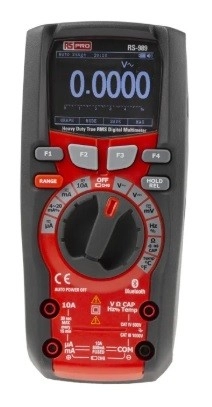193-8694 - RS Pro DMM with Kelvin (4-wire) small resistanc
RS PRO RS-5302 Handheld Digital Multimeter with Kelvin Small Resistance Measurement Feature
Introducing the RS PRO RS-5302 Handheld Digital Multimeter, designed with a Kelvin Small Resistance Measurement feature. This is an ideal multimeter that has the ability to measure capacitance, voltage, and electrical current, with the added benefit of being able to take precision low-value resistance measurements. It offers a robust and compact design, allowing for portability and protection from harsh working environments. A high-quality RS PRO digital multimeter like this is an essential addition to any engineer’s or technician’s test and measurement kit for accurate and reliable results.
Features and Benefits:
- This RS PRO Digital Multimeter is compact and handheld tester with a rugged design, ideal for when working in harsh environments
- It measures capacitance, voltage and electrical current with accurate and reliable readings for the best performance
- In addition to this, the meter features a built-in 4-wire testing measurement for precise low-voltage resistance measurements for added reliability and conclusive results
- The large digital LCD screen clearly displays results with a bar graph visualisation for easy recording of the measurement outcomes
- The digital multimeter offers an auto-power off function after being left idle for 30 minutes, as well as a low battery indicator for easier battery life management
- This multimeter has a low resistant range of 0 – 40 Ω and has a maximum output current of 200mA
- Supplied with a rubber holster, 4 wire cable, test leads, 6 AA batteries, instruction manual and convenient carry case for easy storage and protection of the instrument
Applications:
A digital multimeter or DMM is an essential test tool that measures electrical values such as voltage, current, and resistance. A DMM is used as a standard diagnostics tool or device by technicians and electrical engineers in the following areas:
- Electrical and electronics industries
- Cable installation
- Construction
- Industrial manufacturing
What is the difference between an analogue and a digital multimeter?
The main difference is the display. A digital multimeter will show the results as numbers on a screen (usually an LED or LCD screen) whereas the analogue version has a needle to show the value.
What is the benefit of having a 4-wire or Kelvin Small Resistance Measurement feature in this multimeter?
Accurate and reliable measurement of low-value resistance is very important, especially when testing or completing diagnostics on cables that will be carrying significant current, or dependability is required, for example in medical or military applications. Faulty low-resistance connections have the potential to cause a fire or explosion, which is why the Kelvin method of testing is used. This RS PRO multimeter provides an incredibly sensitive method of testing that can detect faulty crimps, bad solder joins, stress-damaged wires and much more that could cause a lot of damage should they fail if they go undetected.
Is it possible to have this unit calibrated?
Yes, the unit can be calibrated to RSCAL or ISOCAL standards and can be found here:
193-8968 RSCAL
193-8966 ISOCAL
Why RS PRO?
RS PRO is our own brand range and brings you a wide range of high-quality, great value products offering you more choice. Trusted by engineers all over the world, every part of every RS PRO product has been rigorously tested against demanding industry standards; they’re only given the RS PRO seal of approval if we’re confident of their exceptional quality, which means you can be confident too.
Safety Guidelines:
When using any electrical test equipment, it is advised that you refer to the user’s manual for proper working operating procedures and safety precautions in order to avoid potential safety hazards.









